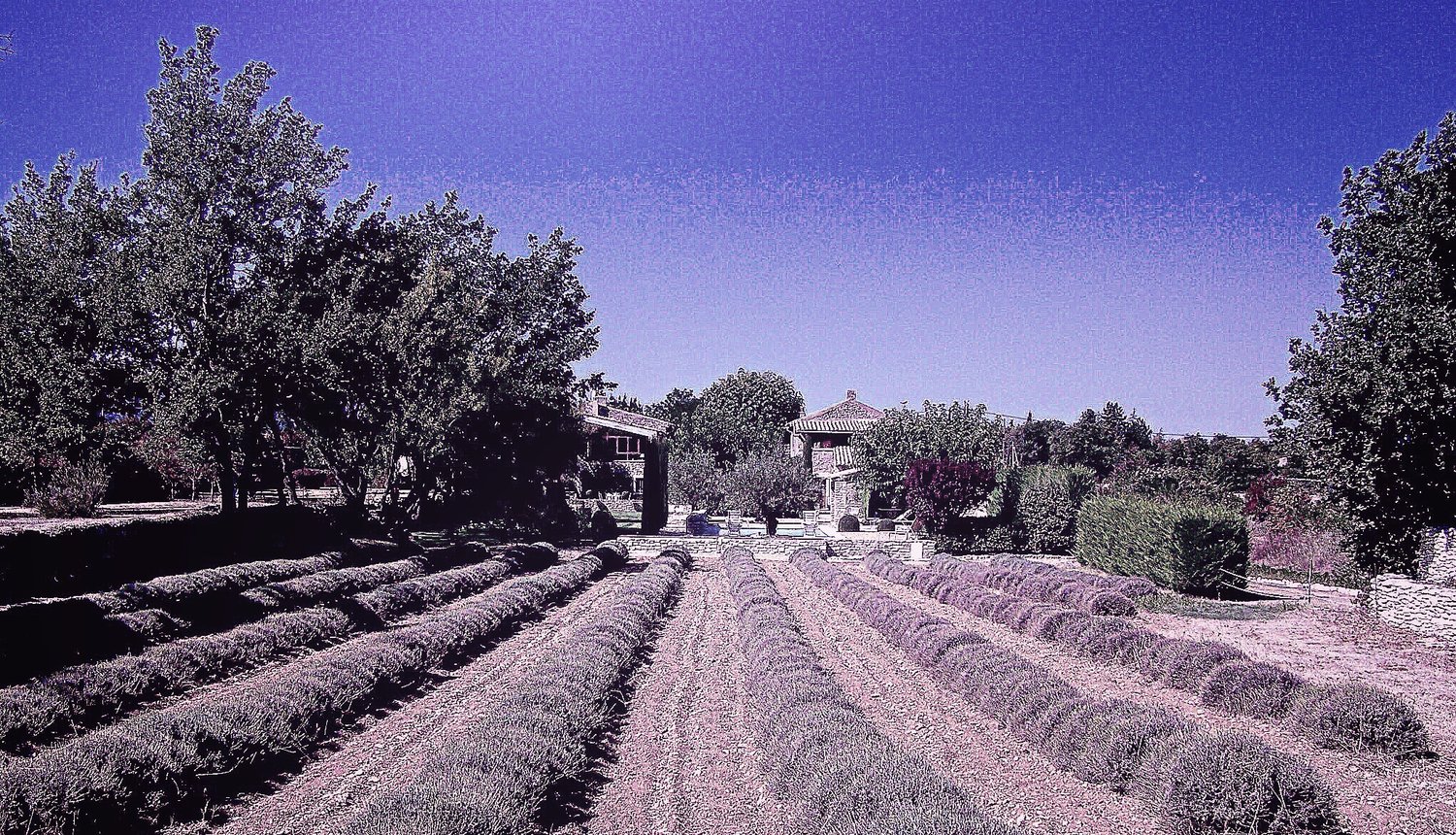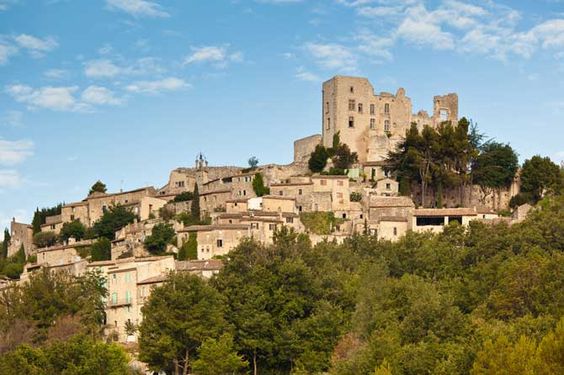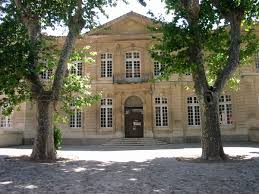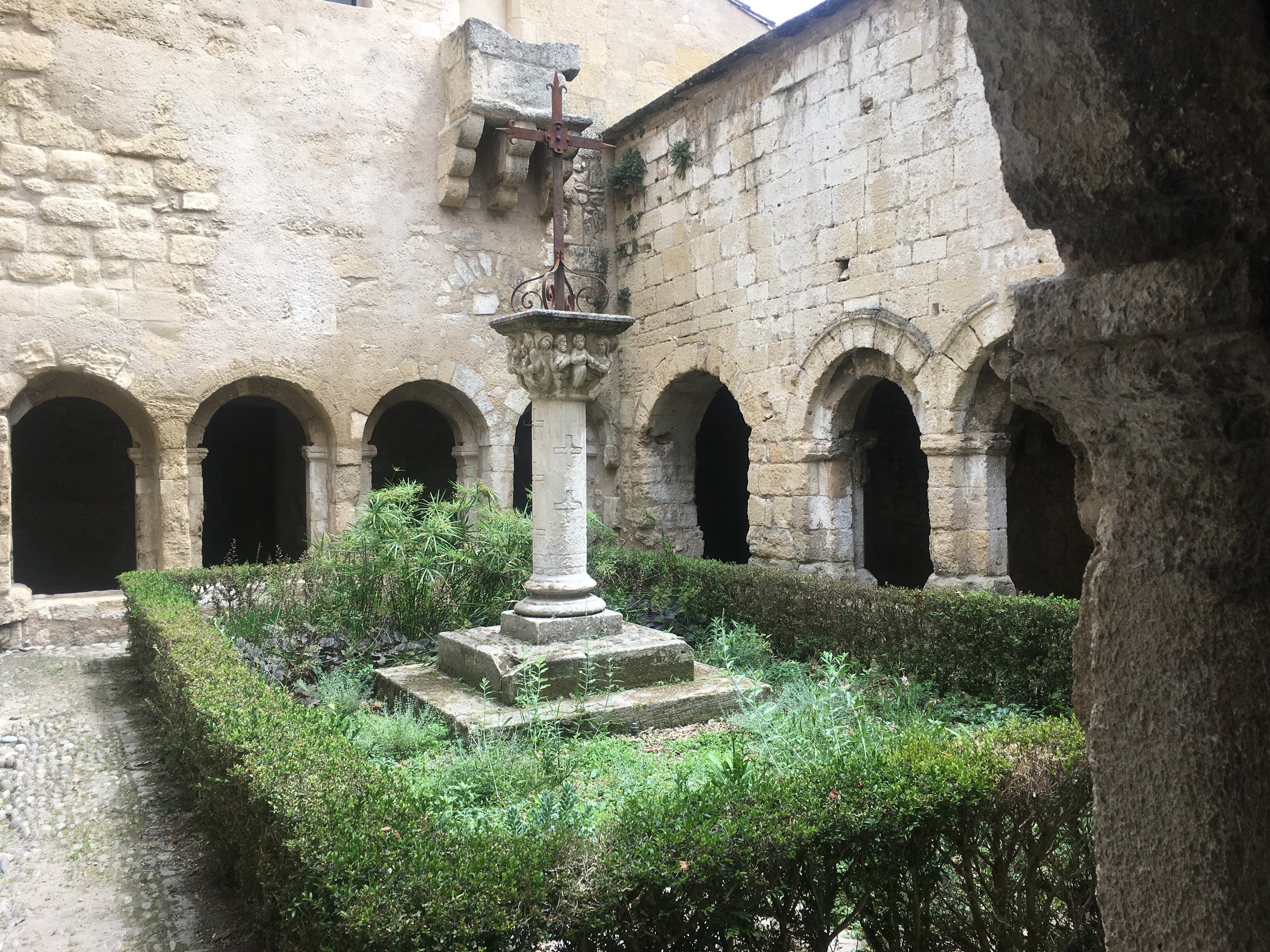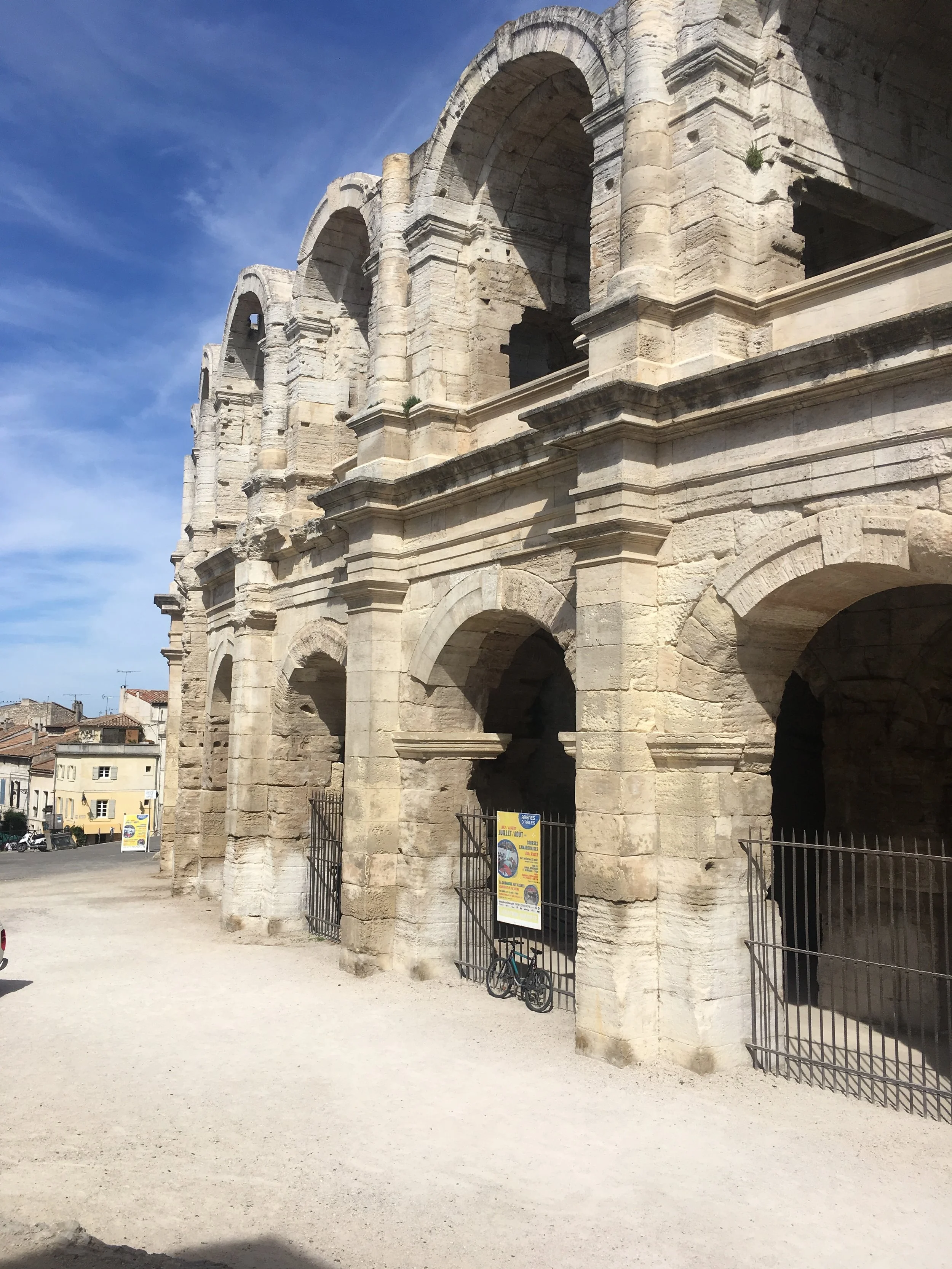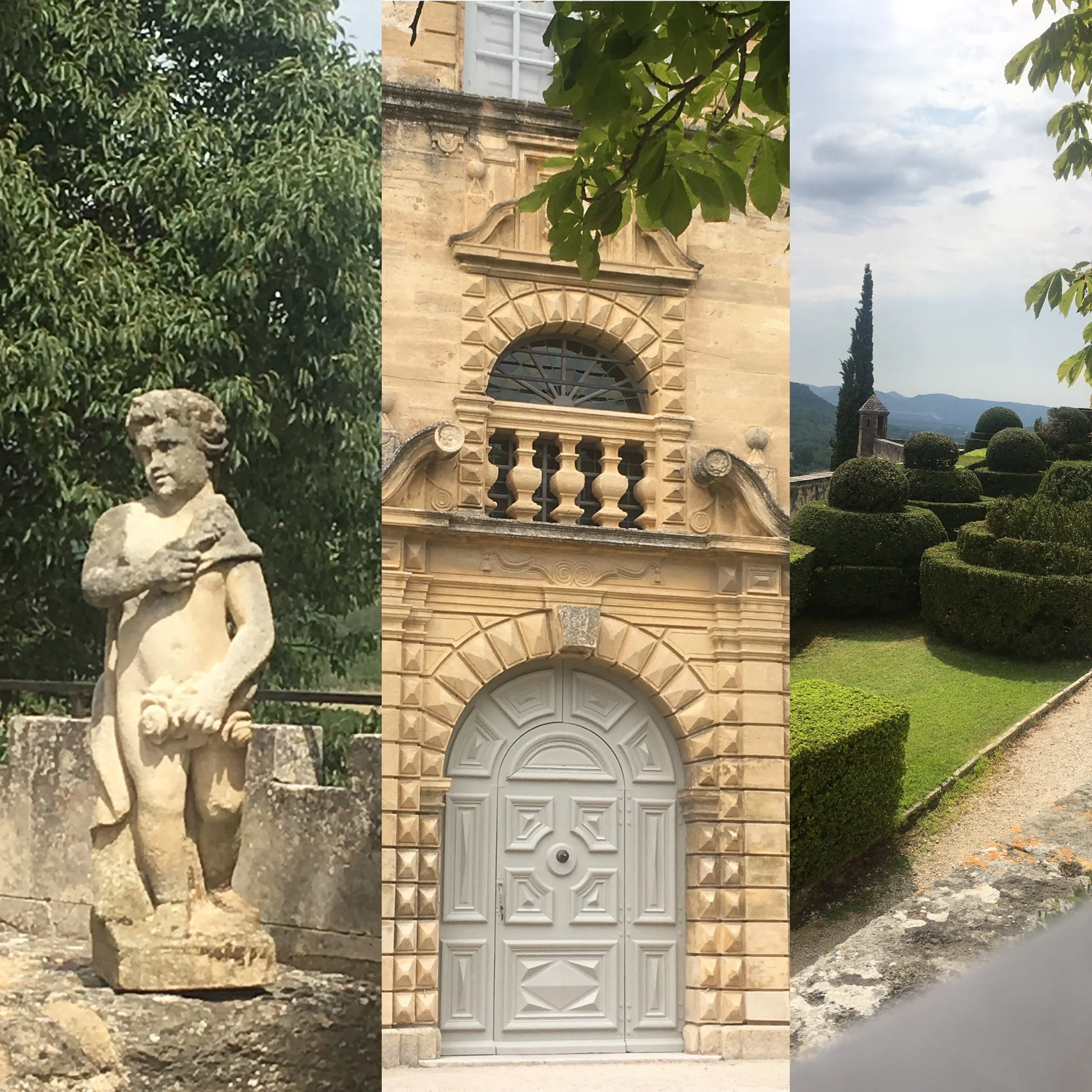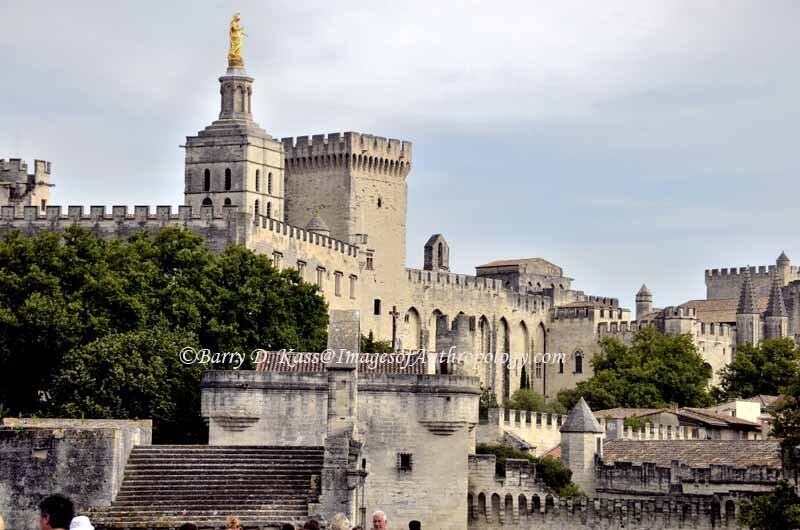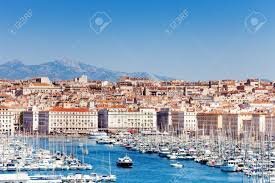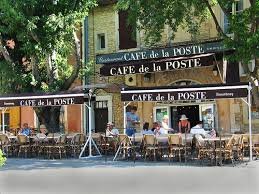the Hill-top Villages of the Luberon: Ménerbes, Lacoste, Bonnieux, Oppède-le-vieux.
The golden triangle is a 10 km area of le petit Luberon where the charming hill-top villages of Ménerbes, Lacoste, Oppede-le-vieux, and Bonnieux are perched. Each village has played their role in the unique history of the region: as a sojourn on the Roman Via Domitia; as a refuge for medieval Christian reformers, les Vaudois; as a stronghold of the papal enclave; or as a centre for 20th century artists. The villages are strung together by winding country roads, perched on hill-tops offering panoramic views of a patchwork of lavender, sunflower and poppy fields, cherry orchards, vineyards and olive groves.
Bonnieux is perched on a plateau across from the village of Lacoste.. Crowned with the high pointed steeple of a 12th century Gothic/Romanesque church, the village has enjoyed a long association with the leaders of the Catholic church: as a Templar Commanderie and as part of the papal enclave, the Comtat Venassin.
Ménerbes was a Roman village, named after the goddess Minerve and an important stop on the Via Domitia. Severely damaged during the Wars of Religion, most of the architecture dates from the rebuilding in the 16th/17th century. Several 20th century artists lived in Ménerbes : Dora Maar (and Picasso), Jane Eakins, Nicolas de Stael.
Oppède-le-vieux was built and owned by the Count of Toulouse in the 12th century. In the 14th century the perched village became part of the papal enclave, Le Comtat Venaissin, but was abandoned in the 17th century and a new more accessible village was created below. During the second World War, the original perched village became a refuge for artists and writers leading to its resurgence as a place to visit after the war.
Crowned by a chateau once owned by the Marquis de Sade, Lacoste is a picturesque village with beautiful views where time has stood still. Settled by Christian reformers in the 14th century Lacoste maintained a contrarian streak: as a Protestant village surrounded by Catholic communities; as a village with a Communist mayor in power for fifty years. Today Pierre Cardin owns the chateau and hosts a musical festival in July.
Les Abbayes in Provence: Traces of the powerful monastic orders.
After the fall of the Roman Empire, monasteries arose as refuges of peace and order in a chaotic world. With their focus on work and discipline, the abbayes became leaders of the medieval industrial revolution and the monks were the keepers of knowledge about clocks, waterwheels, foundries, textiles. In Provence most monasteries date from the 12th century and they were hives of intellectual life until the French Revolution closed the book on abbatial life. Many of the abbeys have been restored as monuments historiques and are open to the public; others have re-opened as monasteries (ie the Benedictine Ganagobie Monastery in Manosque) and can be booked for retreats or rented for private events (Benedictine Abbaye Saint Eusebe in Saignon). For their history and beauty I prefer to visit the following:
The serene Abbaye Saint Hilaire, may not be as well-known as others but the remarkable architecture, setting and story behind it make this Carmelite abbey make it one of Vaucluse's best-kept secrets.
The Carmelites originally lived in caves on Mount Carmel in Palestine. Fleeing unrest in the Holy Land in the 13th century, some of these hermits ended up in Provence, which it is said reminded them of their homeland. They lived in caves at first then, when it was built, the abbey itself.
Built in a mix of Romansque and Gothic styles, the abbeys beauty comes from the harmonious proportions and purity of light. A stone in the cloister marks the date of its construction: 1254.
A privately owned property and listed historic building. The Abbaye de Saint Hilaire is open to visitors for self-guided tours most days between Easter holidays until mid- November . (+33) 4 88 17 80 00
A Cisterican Abbey near the village of Gordes, founded in 1148 The abbey has survived remarkably untouched, and is of a rare beauty and severity. It was at its height during the 13th and 14th centuries but suffered during the Wars of Religion and then was confiscated during the French Revolution.
In the middle of the 19th century a new community of Cistercians repurchased the Abbey but they were later expelled. In 1988 a small community returned. They follow the rule of Saint Benedict and live from by cultivating lavender, an, olive grove, visits to the Abbey, and fascinating monastic shop. +33 (0)4 90 72 02 05/ contact@ndsenanque.net
Two other early Cistercian abbeys in Provence are Silvacane Abbey and Le Thoronet Abbey; with Sénanque, they are sometimes referred to as the "Three Sisters of Provence" ("les trois soeurs provençales").
The Chartreuse de Bonpas, was a fortified convent from the 12th to the 17th century, built by Pope John XXII, on the border between the Comtat Venaissin and Provence, overlooking the Durance river. Located on the riverbanks, at what was a strategic passage point, hence its name ('Bonpas' means 'Safe Passage'). the Chartreuse is screened by umbrella pines and is set in formal gardens with a 12th century chapel that is a listed, historic building.
The Chrtreux are one of the most austere monastic orders: observing an almost absolute silence, frequent fasts and complete abstinence from meat. They are only visited by their families for two days a year. The Chartreux were expulsed during the French Revolution and the buildings were pillaged.
Classed as a Monument historique in 1952,the church as reconsecrated and the property was restored and re-opened to the public in 2003.
The Gardens: Visit My Favorite Gardens in the Luberon.
Beautiful landscapes and views are everywhere in the Luberon, so a garden must have something truly unique to stand-out: a particularly distinctive aesthetic, an ecological stance, a particular purpose or history. Each of the below is quite unique
One of my favorite spots, a beautiful terrace garden created in 1986 by Nicole de Vesians, a stylist in Hermes. It is the archetype of the Provencal garden. The beautiful old stones and plants indigenous to the garrigue blend perfectly with the surrounding nature. The new owners open the garden for privately guided visits for up to 5 people (€100). +33603014312 or Lalouve.bonnieux@gmail.com
The Forêt des cèdres (Forest of Cedars) is a huge park of shady North African trees planted in the 19th century. Near the village of Bonnieux, the forest began during the Napoleonic era. Lovely place for cycling or walks allowing you to escape the hot sun.
Take the D36 south from Bonnieux in the direction of Lourmarin: the route through the Forêt des cèdres leads off on the right about 4 km / 2.5 miles outside the village.
Perched above the vineyards of La Citadelle, the botanical garden has been created on the 18th century terraces which have been restored and landscaped to accommodate a wide variety of medicinal, aromatic, and even magical plants. Also enjoy a unique walk with a magnificent views. A full visit can take 90 minutes and can be followed by wine tasting or a meal in the bistro.
The Chateau Val Joanis is known for its exceptional rosé wines, wine-tasting tours and an award winning garden created in 1978 with the help of landscape gardener Tobbie Loup de Viane, based on images of the stately gardens of the XVIIth century. Three terraces protect the plants from the Mistral and blend lavender, roses, irises, cypresses and other Mediterranean species with a remarkable old-fashioned vegetable garden,
Open most mornings /afternoons. Can be booked for weddings. Check times: +33(0)490798840.
On the lower terrace of the 19th century Chateau de Lauris, there is an award winning garden, created by Couleur Garance, a passionate group dedicated to preserving plant dyes as an alternative to the toxic colourants used today.
An exceptional collection of colourful plants and above all a conservatory preserving 250 different plants traditionally used to create colours for dyes, paints and inks.
A fascinating garden and source of inspiration for botanists, scientists and artists. Open to the public for visits from May to October.
The Centres d’Art: World class art Exhibitions in Aix-en-Provence and Avignon.
Many of the villages of the Luberon have small art galleries, which are worth a look, but Aix-en-Provence or Avignon are the destination for bigger exhibitions. The Centres d’art in Aix-en-Provence are well loved for their exhibitions, musical evenings and beautiful settings for dining during the days and the evenings.
The Collection Lambert , housed across a pair of magnificent 18 century mansions in the centre of Avignon, features an exceptional collection of modern art from the second half of the 20th century, Major works by Jean-Michel Basquiat, Sol LeWitt, Robert Ryman, Nan Goldin amongst many others. In the summer the museum is open daily. From September to June, the museum is closed Monday and Tuesday.
The Cantini Museum has a panorama of modern art housed in a 17th century mansion. The permanent collection includes works from post-impressionism, fauvism, cubism, various post-cubist trends of the 1920s and 1930s. Surrealism forms a major axis of the collection, due to the historical links with Marseille, which welcomed surrealist artists, writers and anti-fascist activists fleeing Nazism. From July 5, 2024, the collection displayed is being renewed with works taken out of storage. Open Tuesday to Sunday from 9:00 to 18:00 /closed Mondays +33413948330
Located in the Mazarin neighbourhood and housed in a beautifully restored 17th century palace, between a garden and a courtyard, the Centre d’art Caumont hosts many exceptional exhibitions including: Botero, a dialogue with Picasso; and the much praised Nicholas de Stael in Provence. Currently there is an exhibition on Marc Chagall and his evolving visual world focussing on work from the last year’s of his career.
Located in the very center of Aix en Provence, the Hôtel de Gallifet hosts artistic events for all art lovers. Nicolas Mazet threw open the doors of his family-house in 2010 as an innovative art centre which offers outdoor concerts and a program of conferences. Simple light dining in the garden is available. An adjoining boutique offers a quiet reading area and a selection of artists’ creations as well as art books published by the Hôtel de Gallifet.
The Musee Calvet, one of the top museums in France, is housed in a beautiful 18th century mansion. The collection was originated by an Avignon physician, Esprit Calvet and ranges from ceramics and furniture to fine arts. There is a special display dedicated to the Avignon School of painters. There is also a new wing dedicated to more modern art which has works by Bonnard, Manet, Sisley, Vuillard. +33490863384
The Granet museum is housed next to the church of St-Jean-de-Malte, in buildings previously owned by the priory. Restored in 2006 for the centennial of Cezanne’s death, the museum has a good permanent collection of Cezanne, Nicholas de Staël, and the very impressive XXe collection on loan from the Foundation Planque until 2026, the personal legacy of Jean Planque, a close friend of Picasso. + 33 (0)4 42 52 88 32
Les Villes du comtat Venaissin: the remarkable history of the Papal Enclave in France
Until the French Revolution, much of the Vaucluse départment belonged to the Pope, as a papal enclave called the Comtat Venaissin. Ceded to the Holy See by Alphonse II, the Count of Toulouse in 1274, the Comtat was named after its former capital Venasque. Carpentras became more important when the Pope Clement V made it his residence and it became the capital city in 1320. The towns of the Comtat were settled by courtiers working at the papal court (such as the father of Petrarch who settled his family in Carpentras), but also many wealthy Italian merchants attracted by the court in Avignon as the new seat of Western Christianity. Avignon, Carpentras , Cavaillon , and L'Isle-sur-la-Sorgue were also home to important Jewish communities; following their expulsions from the French territories in 1394 these cities were some of the few places that Jews were permitted to reside (albeit with restrictions) Traces of this remarkable history can be found in nearby town of Cavaillon (including a remarkable Jewish synagogue from the 18th century) and Isle-sur-la-Sorgue (Jewish cemetery), in addition to the Luberon villages of Bonnieux and Oppede-le-vieux where one sees traces of the Italian Renaissance architecture in the religious buildings and the historic homes which once belonged to the pontiffs or wealthy Italian merchants.
Archeological sites: Tracing the Footsteps of the Romans in Provence
The Romans had a presence in France for over 500 years their presence is still highly visible in Provence. The Via Domitia passed right through the region and many of the local villages can point to a landmark or artefacts from that time: the Pont Julien near Bonnieux and Lacoste; the underground amphithéâtre in Apt; the archeological museum in Cavaillon which is treasure of artefacts from the Romans, Gauls and Greeks.
One can virtually immerse oneself in the time period in places like Arles, Orange, Nîmes and Vaison-la-Romaine which have inherited a rich legacy from antiquity and boast some of the best preserved Roman remains in Europe.
Vasio (present day Vaison-la-romaine) became one of the wealthiest cities in Roman Provence. The ruined remains of the Gallo-Roman city include a Roman bridge from the first century BCE which is still in use in addition to two main sites.
At La Villasse, a magnificent paved street, raised and colonnaded, runs straight through the central district, flanked by luxurious houses, shops, baths, gardens, and fountains. At Puymin, you can see the remains of the Roman theatre (heavily restored), a rich private domicile of exceptional size, and a porticoed sanctuary.
The archeological museum is in the centre of the Pymin site and includes a rich collection of artefacts such as this burial mask and many imperial statues from the wall of the Roman theatre.
Once called the little Rome of Gaul, Arelate, (modern day Arles) was a significant Rhône River trading centre for the Romans. A number of Roman structures from the period are still standing including a finely preserved amphitheatre ( les Arènes d’Arles), a theatre, the baths (Thermae of Constantine), a fascinating necropolis (the Alyscamps), A UNESCO World Heritage Site also for the remains of its Romanesque (early Christian history), Arles made headlines recently when a bust of Julius Caesar, was found and is considered to be the only known portrait-bust of Julius Caesar carved during his lifetime. Les Arènes remains a site for concerts and special event including bull-fights and exciting bull-running events.
Don’t miss Alyscamps, the largest graveyard in Gaul, which follows the custom of the Romans to bury their dead on the roads leading out of town. Those who could afford it had their remains sent to Alyscamps to be buried in a stone sarcophagus, which are lined up along the road. Many were later looted or re-used as altars but the place remains an enchanting place which has attracted many writers and artists (Rainer Maria Rilke, Van Gogh).
Nîmes was known to the Romans as “Nemausus”, and it is one of the most impressive ancient sites in Europe. Technically located in Languedoc-Roussillon, with historic and strong ties to Provence given its position on the Via Domitia which crosses the Rhone. It became a Roman colony sometime before c. 28 BCE. The Roman architectural remains including the so-called Maison Carrée (Square House), an admirably preserved first century BCE Corinthian temple, commissioned by Marcus Agrippa. The amphitheater of Nîmes, known as les Arènes was build around 70 CE to hold 24,000 spectators. It still draws large crowds during its two annual bullfights The Musée de la Romanite (Museum of Roman Civilisation), is highly recommended for its extensive, well preserved and intelligently presented collection including exquisite mosaics. The upper level houses a fine contemporary brasserie La Table du 2, with close-up views of the Arenes.
Les Châteaux de Provence :
Provence is known for the beautiful architecture and the mysterious ruins of its many different chateaux: the medieval chateaux forts from the XII century, built to protect a count and his property (Tarascon), (Lacoste, ) (Entrechaux); the Templar residences which housed the important leaders Knights of Saint-Jean-de-Jérusalem (Mons); the residences of religious families (xxxx) some of which were connected with the pope’s stay in the XIV century (La Charteuse de Bonpas); the more recent chateaux built during the renaissance (Gordes), (Lourmarin) ; the chateaux also known for their beautiful gardens (St Sauvan, Mane) (Le Barroux), (Ansouis); and the chateaux which house some of the important vignerons of the region (Châteaurenard).
La Route des Chateaux in Provence is a great way to start this exploration: 5 privately owned residences open their doors so you can discover the exceptional gardens, architecture and interiors of some illustrious Monuments Historiques. The full itinerary winds from Lourmarin through Aix to la Haute Provence, a picturesque route that immerses you in the beautiful landscape of Provence: https://Contact60462.Wixsite.com/Laroutedeschateaux
The medieval fortress originally belonged to the Counts of Forcalquier and then the Counts of Provence before being enlarged to become a family summer residence in the 17th century. Both incarnations are very much in evidence.
Visits are guided by the very knowledgeable owner who has furnished the chateaux with her impressive collection of period pieces and restored the beautiful interiors. Check
The town itself is lovely with a charming gastronomic restaurant, La Closerie and a 16th century boutique hotel Un patio en Luberon .
Originally a medieval fortress, Chateau de la Barben was sold to the Fortin family by roi René in 1474. Transformed in the 17th century, to add a magnificent stone stairway and facade, in addition to the gardens which are a remarkable example of the classic style of the period. Guided visits are available with knowledgeable guides on most afternoons and it is possible to stay overnight in one of the 6 rooms or suites.
Originally a fortress owned by the Baux family in the 12th and 13th century, the Agoult family began the construction of the Chateau de Lourmarin in a medieval style at the end of the 15th century. A splendid Renaissance facade was added by the nephew of Agoult family in the 16th century. Abandoned in the 17th century, the chateau was restored in the 1920’s and now houses the rich collections of the French industrialist, Robert Laurent Vibert.
The chateau welcomes artists in the summer and hosts many classical concerts and exhibition throughout the year. It can also be booked for conferences and events. +33 (0) 490681523
The town of Lourmarin, one of the prettiest in the Luberon is well worth a visits with many boutiques and charming restaurants and cafes.
The Chateau de Sauvan was known as Le petit Trianon de Provence and was owned by a friend of Marie-Antoinette. Superbly restored and refurnished recently by its new owners, the chateau has rebound its beautiful interiors and gardens which have been classified les jardins remarquable.
While not officially on the Route des Chateaux, it would be a shame not to visit le Château de Lacoste. An unmissable jewel, best known for its most notorious resident, the Divin Marquis de Sade and a short walk away from La Raffine. It was owned by the fashion designer Pierre Cardin until his recent death and it is home to the festival de Lacoste which he created. The festival is on in July most years with concerts and plays in the quarry and the castle theatre. The chateau can be visited from June to September although it is designed for events with few rooms to visits. Throughout the rest of year a visit to the castle esplanade offers panoramic views of the castle the Luberon and the medieval village.
Cities with unrivalled history and Culture
The history of the most important cities in Provence is unrivalled.
Aix-en-Provence is known as the city of water. When settled in the first century BC, the Romans found natural springs, which provided the population with both hot and cold water. They called the city Acqua Sextaie and today there is a commercial spa called Thermes Sextius on the site of one of the original thermal baths.
Throughout the old centre and the chic Quartier Mazarin, there are more than 30 fountains embellished with ornate details from the Renaissance. (An interesting way to see the city is a walking tour of the fountains.) The Fontaine Moussue, on Cours Mirabeau is noteworthy as it is a thermal fountain covered in moss and has been standing there since the Romans.
Famous for being the home of Cézanne, one can take a tour of the sites relating to Cézanne including the Atélier Cézanne where he worked for the last four years of his life. Aix-en-Provence is also blessed with some exceptional galleries including the Musée Granet with a room dedicated to Cézanne and the Centre Caumont which puts on high profile temporary exhibitions in a beautiful restored palace from the 18th century.
Aix also has the best shopping in the region with a variety off fashion boutiques and . The market is Tuesday, Thursday and Saturday on Cours Mirabeau and there is a flower market on the same days at the Place de l’Hotel-de-ville.
My favorite spot for restoration is beautiful shady garden of Le Pigonnet.
A cultured and creative city, Aix-en-Provence has always attracted artists and intellectuals. Some of the famous creative people that lived here: Ernest Hemingway, Emile Zola, Albert Camus and Nina Simone.
The capitol city of the Vaucluse, Avignon was also an important city. In the 14th century when it was the seat of the Catholics popes. Today it houses two UNESCO world heritage sites, and is an important centre for the performing arts with Europe’s most important drama festival in July.
The vast Gothic Palais des papes is a must see for visitors. A UNESCO world heritage site, it was the residence of seven Popes from 1309 to 1377 and is a testimony to the wealth and power of Christendom during the Middle Ages.
Art lovers will enjoy a number of small but impressive museums, including the Musée de Petit Palais, where the episcopal bishops once lived, now another UNESCO World Heritage Site, and home to Italian masterpieces ranging from the 13th to the 15th century.
The Musee Calvet, has a varied and rich collection housed in a beautiful 18th century mansion.
The Collection Lambert, features an outstanding permanent collection of modern art by contemporary artists, housed in two city mansions, built side by side - the Caumont House and the Montfaucon House.
For restoration, you can choose from some excellent restaurants offering high French cuisine: Christian Etienne, Fou de Fafa, Hiely Lucullus. I like to follow a morning of art museum with either Vernet 83, a brasserie with a lovely terrace across from Musee Calvet or La Violette, the restaurant next to the Collection Lambert.
The city hosts a wide variety of festivals and events throughout the year, from the popular International Jazz Festival and the Epicurean Festival in summer to a traditional Christmas market in December.
Shoppers must head to the chic and bourgeois quarter of the Rue Joseph Vernet, for designer clothing and luxury goods and at the heart of Avignon, stop at one of the cafés on the Place de l'Horloge and enjoy watching the world go by under the shady plane trees.
Marseille is the second largest city in France, with a history dating back to the ancient Greeks. As European City of Culture in 2013, Marseille was given a facelift which ignited a general gentrification of the urban centre which had become quite seedy. Today the city’s architecture and colourful streets are sparkling. Unique speciality shopping and many points of interest are well worth a visit in addition to the beaches, the old port and Chateau d’If, made famous by Alexandre Dumas.
Chateau Borely, an 18th century chateau in the 8th arroundissement
Musée Cantini, modern art housed in a late 17th century palace in the centre. A who’s-who of 20th century artists: Raoul Dufy, Matisse, Max Ernst, Picasso, Giacometti, 19 rue Grignan +33 (0) 4 91547775
MUCEM, The Museum of European and Mediterranean Culture is the impressive new architectural marvel, on the waterfront next to Fort St Jean. 7 Promenade Robert Laffont, 13002 +33 484 351 313
The shopping around rue Paradis is excellent as independent boutiques mingle with luxury stores, cafes/bars and heritage shops.
For utterly unique shopping experiences:
Maison Empereur, selling the best of French housewares, linens and hardware since 1827 in a multi-storey store on rue des Récollettes
Pere Blaize, herboristerie. Dedicated to la phytotherapie since 1815. Stocked with teas, elixirs and medicinal plants. rue Meolan.
Maison de la Boule in the Panier district, with a lovely courtyard and all the essentials. 4 place des 13 Cantons, 13002 +33 4 88 44 39 44
For restoration, enjoy pastis on one of the many terraces facing the old port and discover la vraie bouillabaisse, in one of many, many iconic restaurants. When I am in Marseille I head for Restaurant Michel a five-star heritage restaurant with sea view in the 7th arrondissement. Two excellent alternatives are nearby in the Vallon des Auffes, a traditional fishing haven. Epuisette is built out over the sea, for exceptional views and gastronomic cuisine. Chez Fonfon looks over charming pretty harbour
Villeneuve-lès-Avignon has a rich heritage and its own personality. It is well worth crossing the Rhône to discover: the imposing 14th century battlements and remarkable gardens of the hilltop Fort St.-André; the Chartreuse de Villeneuve lès Avignon with its peaceful cloisters and art centre, and the Musée Pierre-de-Luxembourg with its remarkable religious art., not to mention the Saturday antique fair which is one of the best in the region.
Located on the right bank of the Rhône in the Gard, close to Avignon (lès means "close to" in Old French), Villeneuve was .a vacation place for the cardinals when Avignon was a papal city, and today it remains an exclusive place to live much as it was in the time of the Popes.
At the peak of the Avignon papacy, unlike Avignon and the Comtat-Venaissin, Villeneuve-lès-Avignon was under the authority of the king of France who built the fortress and the and in 1292 Phillippe le Bel built a tower to control access to the Pont d'Avignon.
In 1356, Pope Innocent VI founded the Val de Bénédiction charterhouse, the largest Carthusian monastery, featuring a church, three cloisters and forty cells for the monks. The Chartreuse housed many treasures in works of art, furniture and a library of rare books. Most of these treasures were scattered, lost or destroyed during the Revolution. Some of them were saved and can be found in the Pierre de Luxembourg Museum and much effort was made to restore the monastery. The mausoleum of Pope Innocent VI miraculously survived the vicissitudes of history. In the chapel, some frescoes by Matteo Giovanetti, who also decorated the Palace of the Popes, have also been preserved.
A visit to the Pierre de Luxembourg Museum is the ideal complement to a visit to the Carthusian monastery. The works of art that survived the revolutionary turmoil and the ruin of the monastery are preserved in this former cardinal's livery, transformed in the 17th century into a private mansion.
The Music Festivals
Whenever I am here between May and October, I make sure to get tickets for a few live musical and theatre performances. Every year I am spoilt for choice with many options to enjoy the music of world class artists in exceptionally beautiful settings.
Each season Pierre Cardin hosts a festival of live music and theatre en plain air in the old quarry of the Chtateau de Lacoste. Traditionally the festival runs from mid-July to mid-August. Check times and performances. www.festivaldelacoste.com +33(0)490759312
The festival continues to live on post the death of Pierre Cardin in 2020 under the leadership of his nephew, Rodrigo Basilicati-Cardin-Cardin hosting innovative cultural exchanges in a 2021 program which has been very well received.
A program of live classical and jazz music performances and ciné-opéra runs from July through October. Hosted in the grounds of the Renaissance château in Lourmarin. www.chateau-de-lourmarin.com
A Luberon institution, this series of concerts attracts some top classical talent to intimate and beautiful church settings, like those at Menerbes and Oppede-le-vieux. The musical menu is usually focused on the baroque period.
www.musicalesluberon.fr
The Avignon Festival is a huge cultural event that takes over the city for two weeks in July. It is mostly theatre and comedy, but there is also some dance and music. The main festival happens in prestigious locations like the Popes’ Palace, while the “Off” or fringe festival happens wherever a veue can be found, even in the streets.
This is an open-air international piano festival attracting some of the world’s best pianists, The main venue is in the grounds of the Chateau de Florans, but it has now spread out to other delightful spots, and the programme has extended beyond the piano, even beyond classical. The Roque d’Antheron festival takes place in July-August. www.festival-piano.com
les Villages des Monts de Vaucluse
Located by the foot of the Monts de Vaucluse there are a number of picturesque villages. The Villages located along the southern slope are easy to access: Goult, Gordes, Roussillon, Joucas
Facing the Luberon, at the foot of the Monts de Vaucluse plateau, the picturesque village of Roussillon is ranked among the most beautiful villages in France.
Located in the heart of the most important ocher deposit in the world, Roussillon owes its fame to its magnificent cliffs and its impressive ocher quarries.To understand the work of processing these pigments for buildings and decoration visit the "Conservatory of Ocher and Applied Pigments" installed in a former ocher factory .The facades of the houses beautifully illustrate the result obtained by the ochres.
Many artists have naturally been seduced by Roussillon: Jean Cocteau, Carzou, Buffet, Ambrogiani ... You will come across some artisan workshops and artist galleries as well as some good restaurants
Goult is the quintessential village of Provence with an interesting history and the unmissable Café de France, one of the most popular café terrasses in the region.
If you do choose to walk around, the Saint-Sébastien Church, is Romanesque, has a single nave bordered by six side chapels and a remarkable baroque altarpiece. It was built in the 12th century at the same time as the château d’Agoult which belonged to an illustrious Provençal family. The chateau is now privately owned and cannot be visited.
At the top of the village stands the 17th century windmill, the Moulin de Jerusalem (occasionally open for visits in the summer).The windmill in Goult was built to make flour and it was doing this until 1919. The name is thought to be in tribute to the lords of Goult who went off on crusades to the Holy Land.
Goult remains a living village with a grocery store, a butcher, a cheese shop, a bakery, a hairdresser. The restaurants are good as is the antique shop.
Perched on the edge of the plateau of Vaucluse, Gordes offers panoramic views of La Vallée du Cavalon. Named the most beautiful village in Provence there is much to visit: Le Chateau de Gordes notable for medieval and renaissance architecture; les Caves de St Fermin, an underground village from the Middle Ages; the 18th century L’Eglise de Saint Fermin..
Other sites not to be missed near the village:
4 km away, visit the Musée du Moulin des Bouillons, with olive presses dating back to the 16th century and la Musée du Vitrail; and do not miss the much photographed Abbaye of Sénanque - Cistercian monks still live there producing honey, lavender essence, and liqueurs and the entire twelfth century ediface is open for visits.
More recently many artists such as Marc Chagall, Victor Vasarely and Pol Mara came to stay in Gordes and it was a centre for the Résistance in WWII, receiving la Croix de guerre for this historical contribution.
